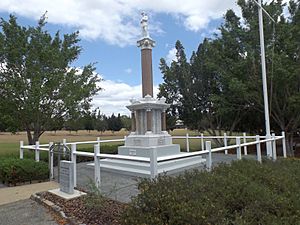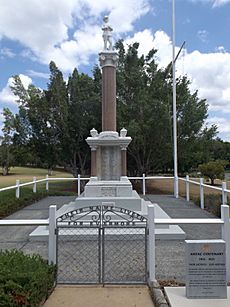Booval War Memorial facts for kids
Quick facts for kids Booval War Memorial |
|
|---|---|

Memorial in 2015
|
|
| Location | Green Street, Booval, City of Ipswich, Queensland, Australia |
| Design period | 1914 - 1919 (World War I) |
| Built | 1919 |
| Official name: Booval War Memorial | |
| Type | state heritage (built) |
| Designated | 21 October 1992 |
| Reference no. | 600550 |
| Significant period | 1919- (social) 1919 (historical, fabric) |
| Significant components | memorial - soldier statue, trees/plantings, park / green space, war trophy/ies, fence/wall - perimeter |
| Lua error in Module:Location_map at line 420: attempt to index field 'wikibase' (a nil value). | |
The Booval War Memorial is a special monument in Booval, Queensland, Australia. It's found on Green Street. This memorial was built in 1919 to remember important events. It is listed on the Queensland Heritage Register, which means it's a protected historical site. This listing helps make sure the memorial is looked after for future generations.
Contents
Why Was the Booval War Memorial Built?
The Booval War Memorial was officially opened on February 15, 1919. The person who unveiled it was Sir Hamilton Goold-Adams, who was the Governor of Queensland at the time. This beautiful memorial is made from marble and granite. It was created by F Williams and Company, a company from Ipswich that made monuments.
The memorial was built to honour 221 local men from the Booval area. These men served in the First World War. Later, new plaques were added to remember 16 people who died in the Second World War. Plaques for other conflicts have also been added over time.
How Was the Memorial Funded?
In 1918, a special group was formed to represent the Ipswich suburbs of Booval, Silkstone, Newtown, and Raceview. This group worked hard to raise money for the memorial. They held fun events and asked people for donations. The foundations for the memorial were even laid by volunteers.
On July 27, 1918, the first stone of the memorial was laid by David Gledson. He was a local politician for Ipswich. The total cost to build the memorial was about £499, which was a lot of money back then!
The Land for the Memorial
The land where the memorial stands was once owned by a person named Harold Foote. Later, it was divided into smaller pieces. In 1914, the Bundamba Shire Council took over the land to create a park. After different councils joined together, the land became part of the Ipswich City Council.
What Are War Memorials For?
Before the First World War, Australia didn't have many public monuments. But after the war, many memorials were built. These became some of Australia's first national monuments. They showed how much the war affected the young country. Australia lost about 60,000 people out of a population of only 4 million. This was a huge loss.
Even before the war ended, people started building memorials. They were a way to show sadness and remember those who died. For many, these memorials were like sacred graves. They were a place to remember Australians whose bodies were buried far away in battlefields.
Remembering All Who Served
Australian war memorials are special because they don't just remember those who died. They also honour everyone who served. Australians were proud that their army was made up entirely of volunteers. These men were seen as heroes, whether they died or not. Many memorials list the names of all who served from a local area. This helps us understand how many people from a community were involved in the war.
War memorials also show us what people valued at the time. They show the skills of local stonemasons, metalworkers, and architects. In Queensland, statues of soldiers were very popular. In other states, tall, pointed monuments called obelisks were more common.
Many First World War memorials have been updated to include later conflicts. Some have also been moved or repaired over the years.
The "Digger" Statue
The "digger" statue is the most common type of war memorial in Queensland. Communities often chose this type of statue. It represented the ANZAC Spirit and the qualities of an ideal Australian soldier. These qualities included loyalty, courage, youth, and strength. The digger statue was unique to Queensland. This might be because other states had groups of artists and architects who advised on memorial designs.
Most digger statues were made by local stone companies. However, some were created by famous artists or brought in from other places.
Daphne Mayo's Connection
The Booval memorial was designed and made by F Williams and Company, a well-known company from Ipswich. Frank Williams, who ran the company, was very respected. A famous Australian sculptor named Daphne Mayo even worked for him. She was an apprentice to learn carving while waiting for a scholarship.
Daphne Mayo is one of Australia's most famous sculptors. She created many important works. These include the carvings on the Brisbane City Hall and the bronze doors for the State Library of New South Wales. She was born in England in 1895 and moved to Brisbane as a child.
It is believed that Daphne Mayo created the soldier statue on the Booval War Memorial. This is because the memorial was built when she was working with Williams. Also, the statue looks very similar to a model she made. The style of the statue was also often used by Williams' company.
What Does the Memorial Look Like?
The First World War Memorial is in a park in Booval, facing Green Street. A low white fence with timber posts and a metal chain surrounds the park. Large fig trees, called Hill's Figs, grow along the edge of the park.
There's a new pathway and plants that are set up around the memorial. The path leads from a new wooden pergola (a garden archway) to the memorial. Between the pergola and the memorial, there's a gun or "war trophy." The path goes around the memorial and then continues to a rock garden and seating area. From there, the path splits off to an exit and a children's play area. New trees line the pathway, and a flagpole stands near the memorial.
The memorial itself is about 22 feet (6.7 m) tall. It has a base, a tall column, and a soldier statue on top.
Details of the Memorial's Design
The memorial is made of granite and marble. It sits on a painted base made of bluestone. Above the base is a pedestal (a strong support). This pedestal has a marble plinth (a heavy base) with decorative edges. The middle part of the pedestal has the names of the 221 local people who served in the First World War. It also lists the 16 who died in the Second World War.
At each of the four corners of the pedestal, there are red granite columns. These columns have special bases and tops, like those found in ancient Greek buildings. These columns support a large cornice (a decorative top edge). On top of the cornice, there are marble urns at each corner.
Above the cornice is a column of red granite with a marble top. On top of this column stands a marble statue of a soldier, known as a "digger." The statue is a bit smaller than life-sized. The soldier stands in a relaxed pose with his rifle resting beside him.
Why is the Booval War Memorial Important?
The Booval War Memorial was added to the Queensland Heritage Register on October 21, 1992. It's important for several reasons:
- It shows how Queensland's history has changed. War memorials like this one show a common part of history for many communities in Queensland. They prove how strong Australian pride and loyalty were, especially during and after the First World War.
- It shows what these types of places are like. The memorial was unveiled in 1919. It is a good example of a monument built to remember a big historical event. It uses the right materials and design. As a "digger" statue, it's also a great example of the most popular type of memorial in Queensland.
- It is beautiful and well-made. The memorial is important because it's a landmark. It also shows high-quality work, design, and materials.
- It has a strong connection to the community. The memorial is very important to the local community. It shows how much a major historical event affected them.
- It is linked to important people. It also has special connections to the F Williams and Company stone masonry firm. And it's linked to Daphne Mayo, one of Australia's most famous female sculptors from the 1930s.


